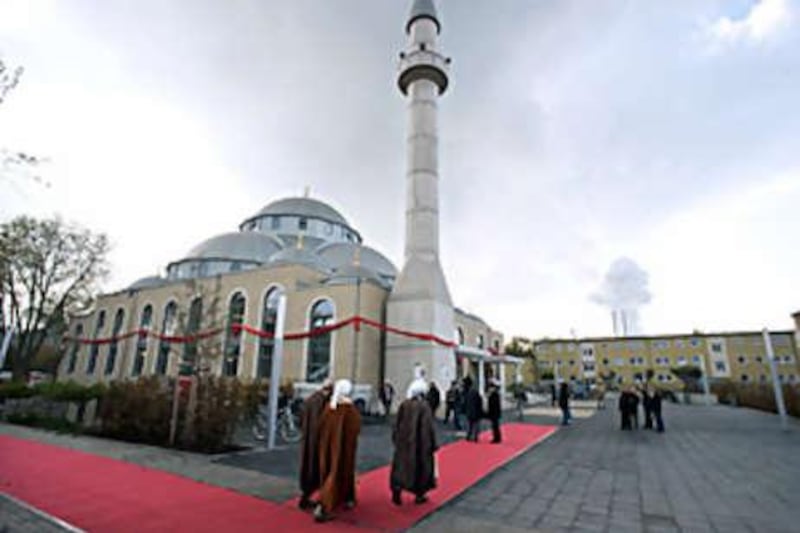The German architect who designed an ambitious, if controversial, mosque in Cologne cannot wait for construction to begin in the new year so that he can watch his dream take physical shape. Paul Bohm, a 49-year-old non-practising Catholic, admits to being nervous, but proud of what he has envisioned. He has good reason. His is a daring design of swirling columns and glass, alongside squat structures and minarets, which has excited and appalled in equal measure.
Traditionalists are unhappy with its modernity, while many non-Muslims say the mosque is further evidence of "creeping Islamisation" in Europe. Thousands protested in the German city. Apart from a few fundamentals - such as the fact that the congregation must face Mecca when they pray and the call to prayer is inappropriate in western secular societies - Muslim activists, scholars and architects argue continually about how the new generation of mosques in Europe should look.
Some insist minarets and domes are essential because Muslim and non-Muslims expect them, though there is no theological imperative to have either. Some say mosques must be self-effacing to avoid upsetting non-Muslim communities. Others say mosques must be brash to show that Muslims are confident. Despite pressure from local politicians, the public and even the church to make the mosque less imposing, Mr Bohm said his designs have remained largely unchanged.
"I only agreed to make the prayer hall more open, more inviting," he said. "People kept saying, 'Oh, make the minarets lower', and I said, 'No'. It would have been a big mistake to make the building quiet." The minarets will be 55 metres tall, a third of the height of the spires of Cologne's famous cathedral, just three kilometres away. "I did not study Islam before I designed it. But I have many Turkish friends and know the kind of places they must pray in. I told them always, it is not right to be praying in these buildings. It makes you seem ashamed. With the new mosque it shows they are proud to be Muslim. It gives them an identity."
Costing ?25 million (Dh128m), the mosque will be built on the site of a factory where Muslims had previously worshipped. When it is opened in 2011, it will accommodate up to 4,000 worshippers, compared to the 600 who cram into the current factory. It will serve Cologne's 120,000 Muslims - just over 10 per cent of the total population. There is no central registry of mosque building in Europe but it is estimated that 184 new mosques are being built in Germany alone, which would more than double the number serving the country's Muslim population of 3.2 million.
Many Muslims in Germany, the majority of Turkish origin, have had to make do with garages, former works canteens and ordinary houses. Now, thanks to money from the Turkish government - acting through its agency, the Turkish-Islamic Union for Religious Affairs - and the prosperity of local Muslims, the days of praying in buildings where cars were once repaired are over. Mosques are also being built in Holland, Belgium, Austria, Switzerland, Italy and England, sparking concern among some that it will create greater division in communities.
"No one has anything against a mosque, but the large projects are Islamic centres that also do social work and child education on the basis of the Sharia. These centres don't help to integrate people, they foster parallel societies," Ralph Ghadban, a Lebanese-born expert on Islam at Berlin's Protestant University of Applied Sciences, told a news agency. The protests against the mosque in Cologne were partly caused by its size and the drama of the design. But they owed much, too, to the fact Cologne is proud of its Christian heritage.
There was no such backlash in Duisburg, an industrial town in the Ruhr valley, when plans were announced to build a mosque in the working class suburb of Marxloh. Though it would be large - able to accommodate 1,200 people - its design was low-key. The budget was ?7.5m, around half from the EU and the state of North Rhine-Westphalia, half raised by local Muslims. The architects could have been more adventurous had they not been under instructions to avoid the showiness of Cologne.
The mosque, which opened last month, is a simple building which could pass as a community centre or a sport hall. The minaret is 34 metres high, a third of the height of the steeple of a nearby church. The windows are plain glass, the minaret just 23 metres high. Inside, the art - designed by a Turkish specialist - is restrained, with the only opulent touch the golden chandelier, with its 99 lamps paying homage to Allah's qualities.
But more than its humble design, there were social reasons for the mosque's immediate acceptance: Marxloh's people, non-Muslims and Muslim, worked, and died, together in mines and in factories. Though those industries have long since faded there is a social cohesion that is absent in Cologne. Wilfried van Winden, 53, a respected Dutch architect who designed a mosque in the south of Rotterdam, a city with 300,000 immigrants, many of them from Turkey and Morocco, living with 300,000 ethnic Dutch, said the role of the mosque was to provide a visible link to the Muslim faith. "It is impossible to give a European identity to a mosque."
For Iqbal Sacranie, the 56-year-old former head of the Muslim Council of Britain, the argument about domes and minarets is irrelevant. "A mosque must be sensitive to the community it is in. It must not create unnecessary commotion. It must teach Muslims to be good neighbours." sfreeman@thenational.ae






